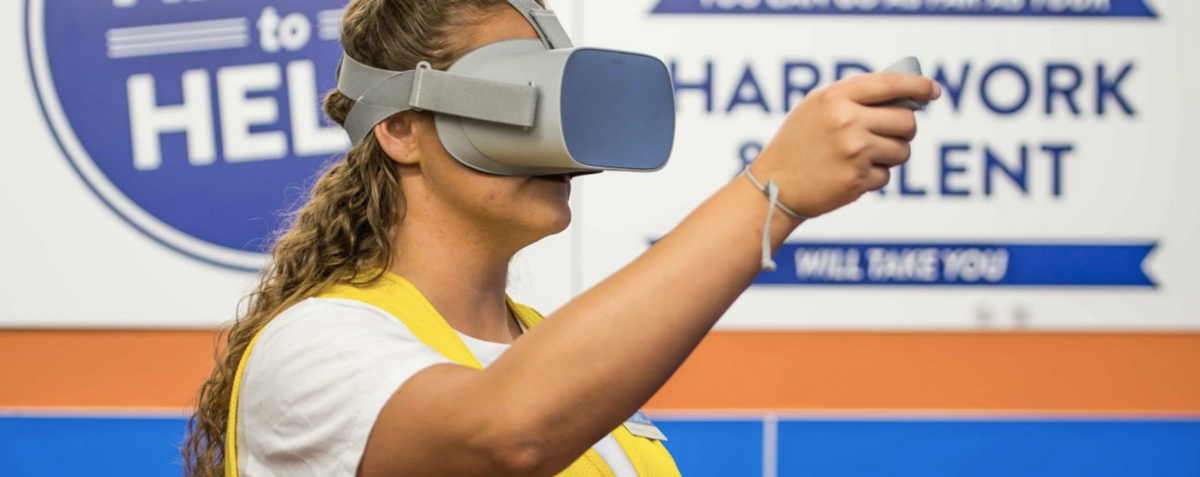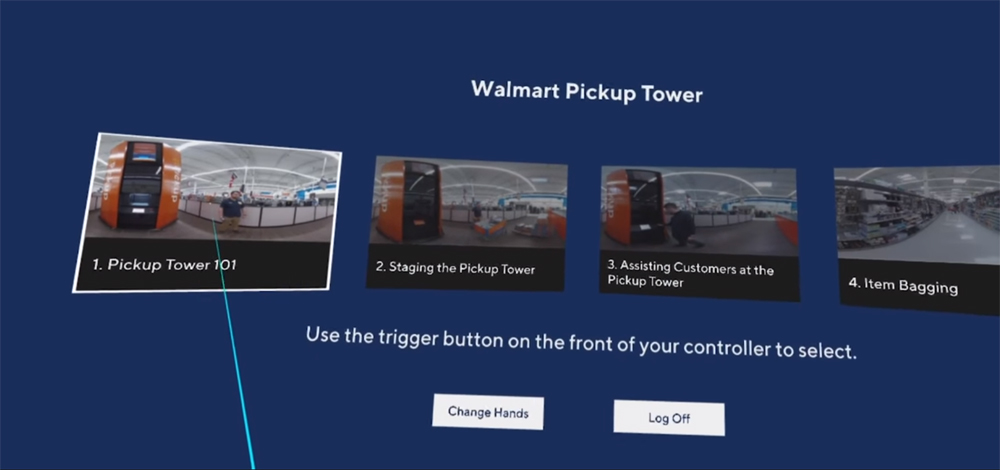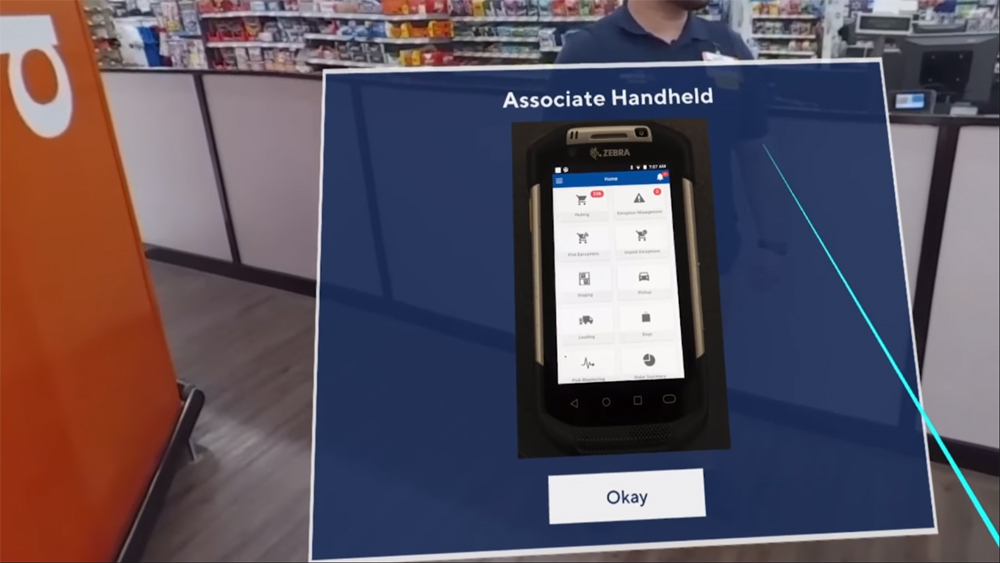Walmart will begin to train their cashiers in virtual reality. Why this could be the future

A few days ago, Walmart talked about buying 17,000 Oculus Go headsets in its blog . She begins to send them to all her supermarkets in North America. Now over one million (!) Employees of the company will have access to training in virtual reality.
This is not a spontaneous decision. Prior to that, Walmart experienced technology for six months at its Walmart Training Academies — training centers where future cashiers, security guards and warehouse workers study (for example, it’s known that there is a whole course called “Survive Black Friday”).The development of a training environment in VR was conducted in collaboration with STRIVR , and Walmart will continue to use their platform, adding new courses there.

Andy Traynor, Head of Walmart Academy, explains the transition of the supermarket to a new technology of personnel training:
The most important thing - learning in VR can be felt, experienced. When you worked out the situation in the headset, your brain thinks you really lived through it. This is a completely different level of cognitive activity. We noticed that training in VR increases staff confidence in real-life situations, and improves test results by 10-15%. Surprisingly, even those of our students who simply watched the person on the headset also showed the same improvements as compared to regular training.
Experts say that even if the “old man” Walmart has switched to VR, this signals the final rooting of virtual reality as a sought-after and relevant technology. Perhaps this is the future of learning. Here all four mandatory conditions are met:
1. Large and ready market
Staff training is important for any corporation. Even just to show how to respond to the inclusion of a fire alarm, or how to work with new equipment. The more such a corporation - the more expensive such training costs. Over 2017, corporations spent $ 360 billion (!) On training employees. On average, $ 1075 is spent on one person being trained, and for industrial enterprises the amount is even higher. Even if you personally buy each employee on a headset with the program, it is cheaper.

2. Tangible benefits
Corporate training is not only very expensive. They are also extremely ineffective. According to Deloitte , 37% of managers believe that this is a waste of time, and 40% of employees say they will not be able to repeat what they have tried in practice.
VR is also not a panacea, but if you believe Walmart, the results are better here. And this is only the first few months, without a really spent software. Information is remembered much deeper. Instead of listening to a lecture, writing things down in the outline or watching someone's actions, a person can experience the whole process himself. The NTL Institute for Behavioral Sciences has released a study that says that through VR subjects in their immersive tests, up to 75% of information was memorized - instead of 5% for lectures and 10% for reading.

3. Ease of use
Oculus Go - this is not the first VR headsets that need to be configured, messing with wires and something to figure out for yourself. It just put on - and forgot. The fact that Walmart is now purchasing them suggests that this technology is now suitable for even the most low-skilled employees. Devices have become easy, do not require training, installation of sensors in the room and other additional equipment. Even the binding to the PC via cable, like that of the Oculus Rift, is no longer there: move as you feel comfortable and natural.

4. Availability of content
Of course, iron alone is not enough. We need software that can reveal its potential. Here Walmart is very lucky with the firm STRIVR. She develops VR training programs for businesses. Her specialization is complex and risky procedures that we face in real life not so often, but which can cost a lot of money (or lives). In VR, a full-fledged workplace is recreated - the way it would look in real life. And then the employee is invited to respond to this or that emerging situation. From answering a customer request to FIRE, NOW ALL WILL EXPLODE IF YOU DON'T TURN THIS VENT. The worker experiences his worst nightmares, but he understands how he needs to act, and what he can make a mistake about.
Prior to this, STRIVR helped American football teams improve their field performance with VR. She also developed a virtual reality program for JetBlue (to train pilots / flight attendants / airport crew) and United Rentals (for builders and foremen). Together with Walmart, STRIVR has now developed 45 training modules. That is, 45 individual virtual locations with their own tasks and difficulties.

Walmart says, for now, they are focusing on developing empathy, customer service skills, and especially on the proper use of new technologies:
This summer, we conducted a test test of VR training in 10 supermarkets. Learning in VR has proven very effective in mastering new devices, like our pick-up towers , which we developed just a few months before. With virtual reality, we were able to start coaching staff before these towers were installed in their supermarkets. We just sent them headsets, without trainers or any instructions. Everything is already in the program.
At Walmart Academy, 70% of the students who sat in VR performed better on the exam than those who used traditional preparation methods. Their assessment of satisfaction with their studies also increased by 30%.
Can virtual and augmented reality help offline retailers?
Retail is already changing very much under the influence of VR and AR. True, not yet with us, but mainly in Europe and the States. Walmart was not the first. Brands such as IKEA, Sephora, L'Oreal, Lowe's and dozens of others are introducing these technologies to make the lives of their customers a bit more interesting and easier.
IKEA was one of the first with its AR-app for smartphones in 2013, and then its updated version, IKEA Place, launched in 2017. In it you can see how the selected furniture will look in the interior of your home. A similar application, just for clothes, was presented a little later by the GAP chain of stores - so that you can try on jeans and T-shirts by yourself without leaving your apartment.

Lowe's, a chain of stores with household goods, a garden and a garage, set up a special room for Holoroom How To in a dozen of its stores. There, visitors can learn DIY, understand how to putty walls, lay tiles, and generally work with tools purchased from Lowe's. Even before making a purchase, those visitors who are worried about something can check how relevant this item will be in their home. Usually the concept of “Try it before you buy it” does not work very well for paints, electric planers, saws and perforators, but Lowe's expects that with VR it can change that.
From the same series - large shopping centers in the US and Europe, which are gradually moving to virtual fitting rooms (look like large full-length mirrors). Looking at them, customers can try on things without putting on anything physically. They say it boosts sales well: the user quickly finds what interests him. Well, now the biggest retail chain in the USA has become a supporter of VR.
PS The entire range of American Walmart (20 million products) can be bought from them in the online store . The same Oculus Go, for example, costs $ 199 (13 thousand rubles), instead of 20-25 thousand rubles in Russia.
Well, purchases from any American online stores in the CIS countries can deliver Pochtoy.com. A kilogram of ordered items on the stock, we deliver for only $ 11 (instead of $ 16). For readers of our blog after registration, there is a discount of another 7% using the HABR code.

